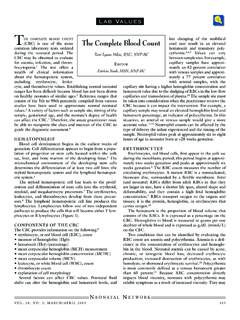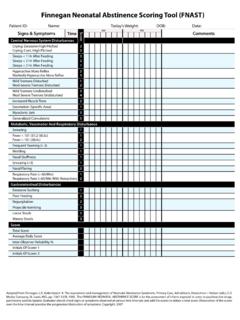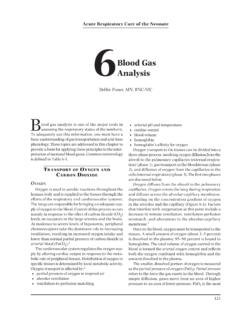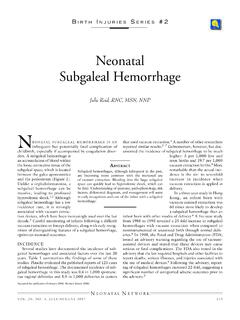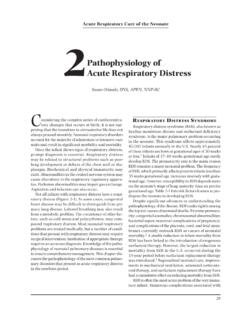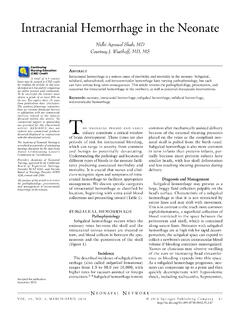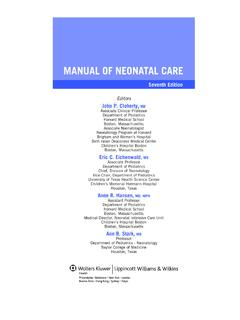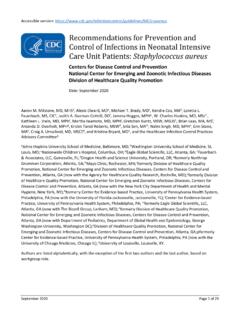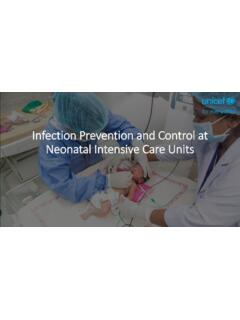Transcription of Understanding Neonatal Ventilation: Strategies for ...
1 Neonatal NETWORK246 2013 Springer Publishing Company JULY/AUGUST 2013, VOL. 32, NO. 4 for publication March Nursing Education (CNE) CreditA total of contact hours may be earned as CNE credit for reading the articles in this issue identifi ed as CNE and for completing an online posttest and evaluation. To be successful the learner must obtain a grade of at least 80% on the test. Test expires three (3) years from publication date. Disclosure: The author/planning committee has no relevant fi nancial interest or affi liations with any commercial interests related to the subjects discussed within this article. No commercial support or sponsorship was provided for this educational activity.
2 ANN/ANCC does not endorse any commercial products discussed/displayed in conjunction with this educational Academy of Neonatal Nursing is accredited as a provider of continuing nursing education by the American Nurses Credentialing Center s Commission on , Academy of Neonatal Nursing, approved by the California Board of Registered Nursing, Provider #CEP 6261; and Florida Board of Nursing, Provider #FBN 3218, content code 2505. PROVIDING R ESPIR ATORY SUPPORT IN THE SICK OR PR ETER M neonate is a signifi cant component of the care deliv-ered in the Neonatal unit . Many of the neonates admitted to Neonatal care require some degree of mechanical ventila-tion. A core aim of Neonatal ventilation is to achieve adequate gaseous exchange without any resultant lung injury or chronic lung disease (CLD), 1 a potential and signifi cant long-term effect of prolonged mechanical ven-tilation in the Neonatal period.
3 Understanding the complexi-ties of care given to any neonate requiring mechanical ventila-tion is essential to deliver safe and effective care . The range of modes and parameters in ventilation practice can pose a challenge for both the novice nurse and for those more experienced who require an update of knowledge. The deci-sion to use a specifi c type of strategy depends on a complex interplay of factors such as the nature and progression of the underlying condition, the state of the lungs, age, and ges-tation. The fi rst aim of this article is to provide the reader with an Understanding of the range of Strategies used to fully support the neonate s respiratory system in the intensive care unit .
4 Secondly, the article will outline the factors that can guide and assist decision making for learners in this area of practice. The reader is directed to many sources for further reading in this area that provide an overview of ventilation modes and Strategies in Neonatal practice. 1 13 Neonatal POSITIVE PRESSURE VENTILATION: OVERVIEW Ventilation Strategies can be viewed across a continuum of dependency starting with the neonate who requires oxygen only, through to the fully ven-tilated neonate requiring inten-sive care . This article will focus on the latter area; that of positive pressure ventilation for the intensive care neonate specifi cally. Positive pressure ventilation (sometimes referred to as mechanical, mandatory, or intermittent positive pressure ventilation [IPPV]) is a term that applies to the whole spec-trum of ventilation modes that deliver pressure according to ABSTRACTN eonatal ventilation is an integral component of care delivered in the Neonatal unit .
5 The aim of any ventilation strategy is to support the neonate s respiratory system during compromise while limiting any long-term damage to the lungs. Understanding the principles behind Neonatal ventilation is essential so that health professionals caring for sick neonates and families have the necessary knowledge to understand best practice. Given the range of existing ventilation modes and parameters available, these require explanation and clarifi cation in the context of current evidence. Many factors can infl uence clinical decision making on both an individual level and within the wider perspective of Neonatal care . Understanding Neonatal Ventilation: Strategies for Decision Making in the NICU Julia Petty, BSc, MSc, PGCE, MAAP, RGN, RSCN VOL.
6 32, NO. 4, JULY/AUGUST 2013 247 Neonatal NETWORKthe neonate attempting to breathe and the ventilator deliver-ing a mechanical breath. Synchronized Intermittent Mandatory Ventilation (SIMV)SIMV delivers a predetermined number of breaths per minute (BPM), but the breaths are triggered by detecting the neonate s spontaneous breathing efforts and synchronizing the delivery of the ventilator breaths to match the neonate s own breaths. 2 4,6,7,13 In SIMV, the neonate can take addi-tional spontaneous breaths between the ventilator-assisted breaths. SIMV can be used to wean the ventilator support and move toward extubation by reducing the preset rate and pressure over time. If a neonate has a high respiratory rate, it is challenging for him to fi t all his own breaths along with those set as backup into one minute, unless the inspiratory time (I T ) is minimal (less than seconds; see later section).
7 This mode is a widely used choice in Neonatal practice. 5 Patient Trigger Ventilation (PTV) or Assist Control (A/C)For this mode, each time the neonate starts to breathe, this triggers the ventilator to deliver a breath or assist the neonate s breath at a set pressure and I T . Therefore, the rate delivered and recorded is determined by the neonate. If the neonate becomes apneic and does not trigger a breath, the ventilator will deliver the set backup rate, again with the predetermined pressure and I T . This mode can also be used to wean from ventilation support by reducing pressure only, because rate is controlled by the neonate. A meta-analysis 14 comprising 14 studies concluded that triggered ventilation leads to a shorter duration of ventilation overall as well as a reduction in air leaks compared with mandatory conven-tional ventilation.
8 Another recent randomized, crossover trial of 26 stable preterm neonates with a mean gestational age of 27 weeks found that a reduced backup rate (30 BPM com-pared with 50 BPM) resulted in greater triggering of breaths and no discernible difference in cardiovascular stability. 15 Supporting a neonate s own respiratory efforts should there-fore be encouraged by the use of triggered ventilation with an optimum backup rate while allowing him to take control of his own breathing in time. Target Tidal Volume (TTV) or Volume Guarantee (VG)TTV or VG can be added to either SIMV, PTV, or A/C. A desired tidal volume (V T ) is set by the operator and delivered by the ventilator using the lowest possible pressure necessary to reach the set volume.
9 A further explanation of V T follows later in the article and within Table 1. TTV or VG ensures that the neonate receives an optimal V T but at minimal pres-sures to avoid the risk of barotrauma 8 and volutrauma to the lungs. It should be remembered that the measured peak inspiratory pressure (PIP) is likely to vary with each breath particularly as the lung compliance changes; in other words, how easy or not it is to expand the lung. For example, as the lung compliance worsens, the desired V T will be more parameters set on a ventilator. It is used for full respiratory support in neonates who have undergone endotracheal intu-bation (Figure 1) and are unable to self-ventilate adequately and where noninvasive methods such as continuous posi-tive airway pressure (CPAP) are not suffi cient to maintain adequate respiratory function.
10 Full ventilation includes fi rstly conventional modes that aim to mimic the normal respi-ratory cycle and are based on traditional pressure-limited, time-cycled ventilators. 11 More recently, nonconventional and newer modes of mechanical ventilation have been intro-duced, including pressure support, volume targeting, and high-frequency oscillation. 2 Adjunct therapies such as inhaled nitric oxide (NO) and extracorporeal membrane oxygenation (ECMO) that are used as rescue therapies for specifi c cases are beyond the scope of this article. VENTILATOR MODES The terminology used to identify modes of ventilation may differ between makes and models of different venti-lators.
